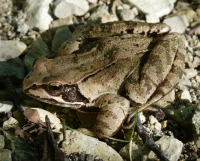Introduction
Rana temporaria, commonly known as the common frog or European common frog, is one of the most widespread amphibians in Europe. Known for its adaptability, it thrives in a range of habitats, from damp woodlands to urban gardens. Unlike some of its more tropical cousins, Rana temporaria is particularly well-suited to colder climates, including regions like the British Isles, Scandinavia, and parts of Russia. Its distinctive appearance and fascinating life cycle make it an important species for understanding the ecology of European amphibians.
Physical Description
The common frog has a stocky body, with a head that is broad and flattened. Its coloration varies widely, usually ranging from olive-green or brown to more vivid shades of red or yellow. This variation helps with camouflage in different environments, whether the frog is in a dense forest or an open field. The skin is generally smooth and moist, with darker markings and spots often found on its back, particularly behind the eyes.
A hallmark of Rana temporaria is the dark “mask” or patch located behind its eyes, which extends down toward the tympanum (eardrum). The underside is lighter, often yellowish or white with darker speckles. Adults typically reach between 6 to 9 cm (2.4 to 3.5 inches) in length, although females tend to be larger than males, especially during the breeding season.
Habitat and Distribution
Rana temporaria is highly adaptable and can be found in a wide range of habitats across Europe and parts of Asia. Its range stretches from western Europe, including the UK and Ireland, all the way to eastern Russia and Siberia. It is often found in forests, meadows, wetlands, and even urban areas like gardens and parks.
This species is particularly notable for its ability to thrive in cooler climates. Unlike many other frogs that prefer tropical or subtropical environments, Rana temporaria can survive in regions where temperatures frequently drop below freezing. It can even be found at high altitudes in mountainous regions such as the Alps and the Pyrenees.
During the colder months, Rana temporaria hibernates, either in mud at the bottom of ponds or beneath leaf litter and logs in terrestrial environments. Its ability to survive hibernation under ice is an adaptation to living in such cold climates, as it slows down its metabolism and absorbs oxygen through its skin.
Breeding and Reproduction
Breeding is one of the most distinctive aspects of the common frog’s life cycle. In early spring, usually between March and May, Rana temporaria returns to ponds, lakes, or slow-moving streams to reproduce. Males arrive at the breeding sites first and use croaking calls to attract females. They often form dense breeding aggregations in shallow water.
During mating, the male clasps the female in a position called amplexus, which is common in many frog species. He fertilizes the eggs externally as the female lays them. A single female can lay up to 2,000 to 3,000 eggs, which are deposited in large clumps called frogspawn. These clumps are often visible floating at the surface of ponds and are an iconic symbol of spring in many parts of Europe.
The eggs hatch within a few weeks, depending on water temperature, and the tadpoles emerge. Tadpoles undergo a metamorphosis over the course of several months, developing from aquatic, gilled larvae into air-breathing, land-dwelling juvenile frogs. By late summer, the young frogs leave the water to start their terrestrial phase of life.
Diet and Behavior
As an opportunistic feeder, Rana temporaria consumes a wide variety of prey. Its diet mainly consists of insects, spiders, slugs, snails, and other small invertebrates. As tadpoles, they are herbivorous or omnivorous, feeding on algae and detritus in their aquatic environment. However, once they metamorphose into frogs, they become strictly carnivorous.
The common frog is largely nocturnal and spends much of its time hiding in damp, sheltered places during the day. It relies on its camouflage to avoid predators, which include birds, mammals, and reptiles. Despite their somewhat sluggish appearance on land, they are excellent swimmers and can move quickly through water to escape danger.
Conservation Status
Rana temporaria is listed as a species of “Least Concern” by the International Union for Conservation of Nature (IUCN), which means it is not currently facing a significant risk of extinction. However, like many amphibians, it faces challenges from habitat destruction, pollution, and the spread of diseases such as chytridiomycosis.
In some areas, populations have declined due to urbanization, agriculture, and the draining of wetlands. Climate change also poses a potential threat, as shifts in temperature and rainfall patterns could disrupt breeding cycles and reduce the availability of suitable habitats. Despite these pressures, the common frog remains one of Europe’s most resilient amphibians, thanks to its wide range and adaptability.
Conclusion
The common frog, Rana temporaria, is a remarkable amphibian that plays a vital role in European ecosystems. Its adaptability to various climates, including cold regions, and its wide distribution make it one of the most successful frog species in Europe. From its iconic breeding behavior in spring to its vital role in controlling insect populations, Rana temporaria is an important and fascinating species that continues to thrive across its vast range, even in the face of environmental challenges.

Leave a Reply
You must be logged in to post a comment.